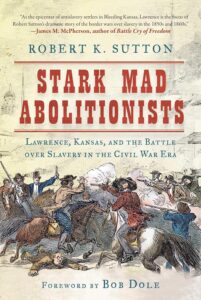Stark Mad Abolitionists: Lawrence, Kansas, and the Battle Over Slavery in the Civil War Era – Robert K. Sutton
 Stark Mad Abolitionists: Lawrence, Kansas, and the Battle Over Slavery in the Civil War Era. By Robert K. Sutton. (New York: Skyhorse Publishing, 2017. pp. 276. Cloth, $24.99.)
Stark Mad Abolitionists: Lawrence, Kansas, and the Battle Over Slavery in the Civil War Era. By Robert K. Sutton. (New York: Skyhorse Publishing, 2017. pp. 276. Cloth, $24.99.)
Stark Mad Abolitionists is a brisk and informative read about the efforts to transform Kansas into a free state upon its induction in to the United States. Sutton is at his strongest when, in the initial chapters, he describes the efforts of Northerners like Amos Adams Lawrence to transplant anti-slavers from the East to the West to create a voting population willing to support Kansas’s entry into he Union as a free state. Kansas was not to be a utopia, but it appears in the initial chapters to be a promised land built on white immigrant belief that slavery should not be permitted in the state of Kansas, despite the violent efforts of nearby Missourians who packed the state legislature with pro-slavery Missourians who did not even live in Kansas. I knew that Kansas became a free state, but Sutton still had me biting my nails as he detailed the violent back and forth.
When the Civil War enters the narrative, Stark Mad Abolitionists becomes a battlefield history, describing the Civil War in Kansas. Sutton is a good writer, and keeps the pace brisk, so this part of the book almost reads like a thriller. It has its stock characters: the heroic free-state Kansans and the evil Confederate guerillas. Again, this was edge of your seat reading. The analytical punch is gone, however, which is too bad, because Sutton is capable of clearly and cogently expressing complicated ideas.
This book is a good starting point for the topic of the coming of the Civil War to battleground states like Kansas, but Sutton’s account begs to be fleshed out. Women appear in his narrative, though mostly as victims. I would love to read a history incorporating more of their voices. Sara Robinson is an especially interesting character. I would also like to hear more about the roles Blacks played in Lawrence. As Sutton writes, Lawrence was a major stopping point on the Underground Railroad. There has to be a rich history of the enslaved seeking freedom just ready to be told. For a book about the battle over slavery, Sutton only represents white voices. Surely there are stories from the Black point of view yet to be told.
This would be a good book for an undergraduate class looking for a case study of the coming of the Civil War. Lawrence represents in a microcosm the conflict playing out in the United States at large prior to the Civil War. I would treat it more like a textbook, as it does present some analysis but falls back into almost pure narrative as the book progresses. It is also a good read for someone like me, who knew nothing about Lawrence, Kansas other than the two times I stayed there during cross-country moves and Sex in the Heartland, by Beth Bailey. If you are looking for a short, informative read on place and the Civil War, this book is for you.
